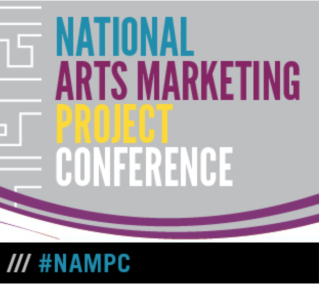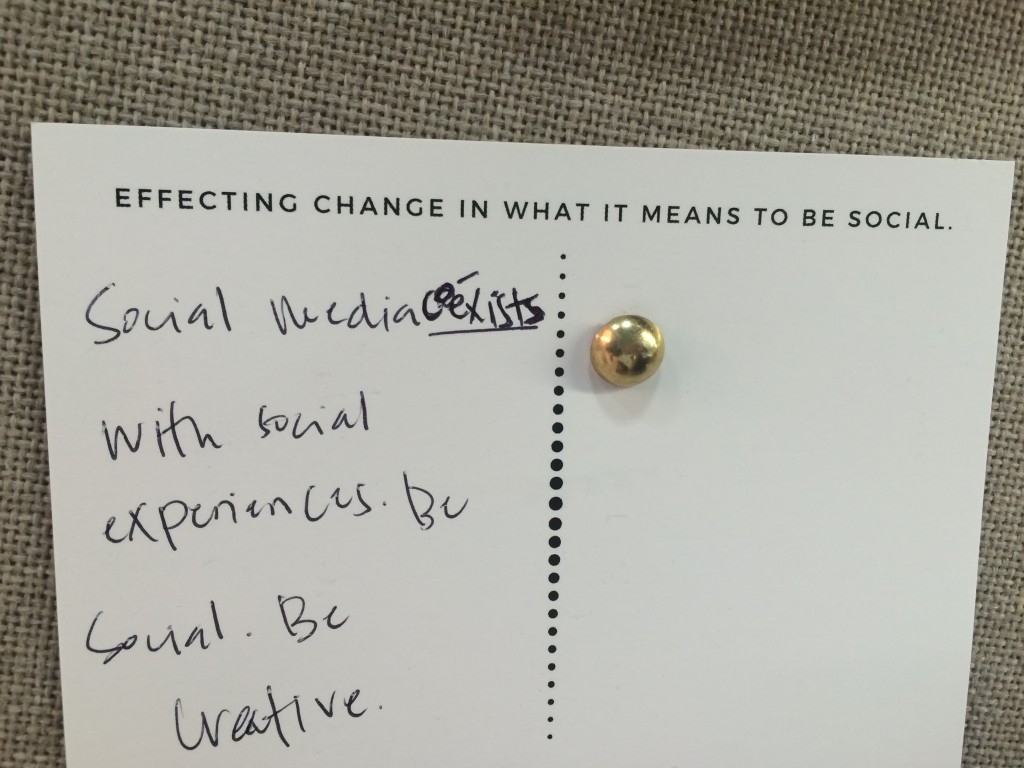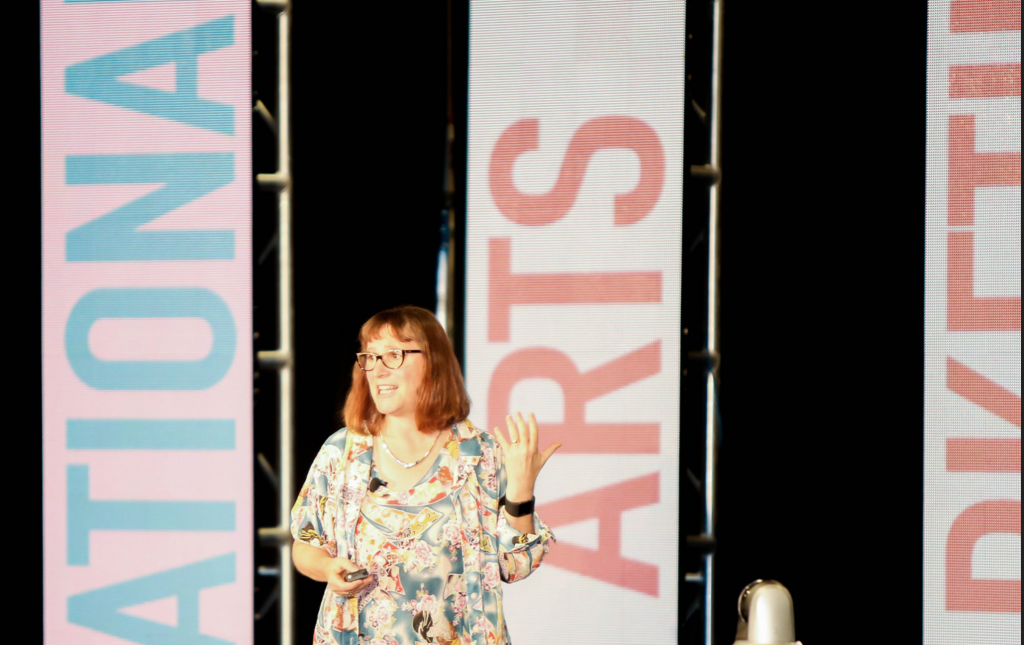NAMPC Series Part 3—Social Media & Social Design
From Grace Robinson, Public Information and Research Coordinator —
 In this third and final installment to my National Arts Marketing Project Conference (NAMPC) mini-series, I’d like to share some great social media marketing tips I learned in a couple different sessions. First a breakout and then, borrowing from the conference structure, what’s a better way to end than with the end keynote with Beth Kanter?
In this third and final installment to my National Arts Marketing Project Conference (NAMPC) mini-series, I’d like to share some great social media marketing tips I learned in a couple different sessions. First a breakout and then, borrowing from the conference structure, what’s a better way to end than with the end keynote with Beth Kanter?
There were multiple social media sessions available throughout the conference, and one that I found particularly valuable was Curating Social Media Engagement with Social Design. Lead by Kelly Page of Live What You Love social design studio and interspersed with real-life examples from Arena Stage and Lookingglass Theatre Company, this was an interactive workshop that was perfect for reviving a knowledge of the power of social media and the desire to use it effectively.
The session opened with an audience poll exercise that was reminiscent of the middle school ice breaker, Ships and Sailors. Kelly would call out a statement about social media and give two options for how that statement could be ended. We would then move to one side of the room, or stand somewhere in the middle, to represent the degree to which we agreed with one end statement or the other. In conclusion, we saw as majority we believed social media to be about conversation, community and movement–not just a wall to throw up posters. However, the reality of how difficult it is to start and carry on fluid conversations in terms of time and staff availability was not ignored.
This brought us to the importance of “curating social media engagement with social design.” What does this mean? It means social media naturally reflects what is happening in the social environment. It means arts marketers should not be developing campaigns to fit into certain platforms, but we should instead be developing campaigns in the context our target audiences’ social environment. Because social media is about a conversation with an audience, both language and context are important.
The session gave four tips given for curating social media engagement: be a storyteller, be a social designer, be a social media curator, be a social researcher.

The purpose and uses of social media were solidified by our final keynote speaker, social media and technology guru Beth Kanter. With her red cowgirl hat in tow, Beth enthusiastically pointed out the far reaching power of social media and led us through ways to use it effectively for an organization. She listed the three technological revolutions we have seen—broadband, mobile and social networking—and it was quite fitting for a marketing conference to end discussing the current revolution we are in, social networking.

Social networking allows for a whole new type of marketing and is ideal for nonprofits as it is virtually free. Additionally, it opens the possibility of reaching an audience through different channels who may not have previously been within reach because of the vast amount of networks online and social media offer.
Organizations, and in our case arts nonprofits specifically, should be leveraging this invaluable resource of social media as a tool to reach and grow our audiences. How can this be done? Although the digital world is in full force and its effect is undeniable, social media is still a relatively new strategy to use for organizational communications. This means that transitions towards effectively using this tool are still in the works. Beth’s belief of the best way to go about this is for institutions to change from the inside out. She calls for organizations to enter into a network mode more than ever before. By staff working together collaboratively and then extending their company network with other business related networks specific to each person, the organization will be able to collectively move towards impact.
Beth’s list of mindsets and skills needed for network leadership:
- listening, engaging and cultivating organization and professional networks
- reputation and boundary management
- build trust, transparency and authenticity
- transdisciplinary learning
- data informed
- and culture of creative replenishment from the inside
She went on to pull out two from the above list: reputation and boundary management and being data informed.
Reputation and boundary management come into play in the line of thinking where organizational reach goes beyond brand presence. Individuals on staff should develop themselves online as leaders and influencers in the industry, be this on Linkedin, Facebook, Twitter, etc., by creating a personal brand. This is a great way to expand the audience of the organizations as the personal accounts will enhance the business’ reach. It will also increase capacity as staff is equipped to lead. Studies have shown that people tend to trust people more than brands, so this is also another way to gain audience trust. However, this comes with the challenge of boundaries and the line between personal and business. The best account direction to go with for a ‘personal’ account that is meant to drive your professional brand and enhance the organization is to be open but be intentional in posts, with an alignment of purpose, audience, persona and tone with the organization.
Another huge advantage in social media is the data that it creates. Most platforms now have measurement tools built within their framework and some are even free. The value of data and seeing audience response is incredibly valuable. Build a data informed culture within your organization, and using data for better decisions will lead to greater impact. Data should be monitored, measured and receive a response. It is always a temptation to start with ‘a great idea’ and then attempt to collect and morph data into supporting this idea. However, ideas may not always be compatible with an audience. Listen to your data; don’t try and force data to ‘listen’ to an idea. The numbers will not always show what was desired or expected. However, failure seen in data is simply an opportunity to improve. It is highly important that data is not simply read—it needs to be processed and time needs to be given to use the results of any data collection integral with company tactics.

Beth left us with three tips, summing up her session to close the keynote:
- empower all board and staff members to leverage personal brand and networks
- balance technical and human data skills—go beyond counting data, learn from and and make changes to improve your art, brand or strategy
- don’t fear risks & failure—as long as you can learn from it, it is valuable
And I too, will leave you with that. Thanks for tagging along on this reflection of NAMPC 2015. If you’re interested in more arts marketing tips and tools stay tuned for sessions offered in the TN Arts Commission’s statewide arts conference this summer, Collective Impact.

